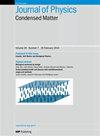自旋分数化和拓扑秩序的场调谐基塔耶夫系统
IF 2.3
4区 物理与天体物理
Q3 PHYSICS, CONDENSED MATTER
引用次数: 0
摘要
蜂巢基塔耶夫模型描述了一种具有拓扑秩序的 Z2 自旋液体,它的激元由间隙 π 通量和自由马约拉纳费米子组成。众所周知,竞争性相互作用,即使不是很强,也会破坏基塔耶夫自旋液体的稳定性。磁场是在基塔埃夫系统的不同相位之间进行调节的方便参数,甚至还被研究用于抵消其他不稳定相互作用的潜在影响,从而导致拓扑相位的恢复。在此,我们回顾了在理解磁场对某些扰动基塔耶夫系统的影响,特别是对分化和拓扑秩序的影响方面所取得的进展。本文章由计算机程序翻译,如有差异,请以英文原文为准。
Field tuning Kitaev systems for spin fractionalization and topological order.
The honeycomb Kitaev model describes aZ2spin liquid with topological order and fractionalized excitations consisting of gappedπ-fluxes and free Majorana fermions. Competing interactions, even when not very strong, are known to destabilize the Kitaev spin liquid. Magnetic fields are a convenient parameter for tuning between different phases of the Kitaev systems, and have even been investigated for potentially counteracting the effects of other destabilizing interactions leading to a revival of the topological phase. Here we review the progress in understanding the effects of magnetic fields on some of the perturbed Kitaev systems, particularly on fractionalization and topological order.
求助全文
通过发布文献求助,成功后即可免费获取论文全文。
去求助
来源期刊

Journal of Physics: Condensed Matter
物理-物理:凝聚态物理
CiteScore
5.30
自引率
7.40%
发文量
1288
审稿时长
2.1 months
期刊介绍:
Journal of Physics: Condensed Matter covers the whole of condensed matter physics including soft condensed matter and nanostructures. Papers may report experimental, theoretical and simulation studies. Note that papers must contain fundamental condensed matter science: papers reporting methods of materials preparation or properties of materials without novel condensed matter content will not be accepted.
 求助内容:
求助内容: 应助结果提醒方式:
应助结果提醒方式:


